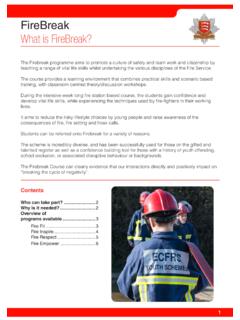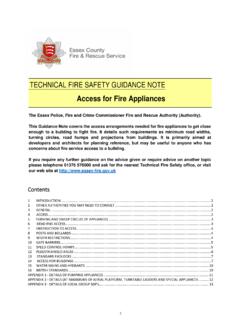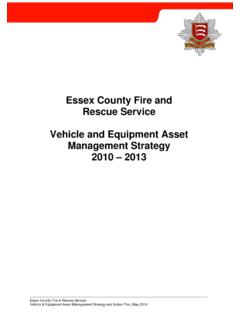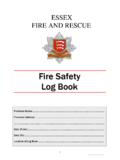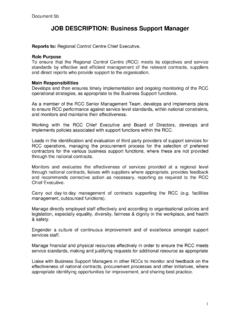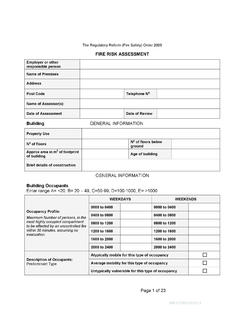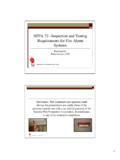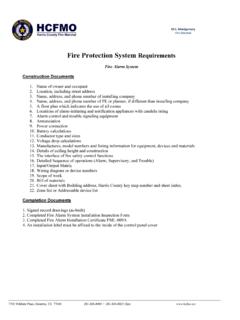Transcription of Workplace Fire Safety FAQs
1 Workplace fire SafetyFAQsWhy the change?Currently there are several pieces of legislation dating from 1947 - 1999. Many businesses have to comply with one or more of these which does cause confusion and conflict. Industry, the Government and the fire Services have streamlined all the legislation into one document. It is a much simpler piece of legislation to follow. It firmly places responsibility for all fire Safety matters with not only the employer, but also the owner of a building (who may not be the employer) and the employees. Who does it affect?The fire Safety law affects all non-domestic premises in England and Wales. You are responsible for complying with this law if you are: responsible for business premises an employer self-employed with business premises a charity or voluntary organisation a contractor with a degree of control over any does the new legislation apply?The Regulatory Reform FSO will apply to virtually all premises and covers nearly every type of building, structure, and open space.
2 For example: offices and shops premises that provide care community halls common areas of houses in multiple occupation pubs, clubs and restaurants schools tents and marquees hotels and hostels factories and excludes domestic premises occupied by a single family group. Responsibility for complying with the Order rests with the responsible person .In a Workplace , this is the employer and any other person who may have control of any part of the premises, the occupier or all other premises the person or people in control of the premises will be responsible. If there is more than one responsible person in any type of premises ( a multi-occupied complex), all must take all reasonable steps to co-operate and co-ordinate with each for each type of building and open space is now on the Department for Communities and Local Government web have a fire certificate. How will the new fire Safety legislation affect it?A business may have been issued a certificate as far back as 1971.
3 When it was issued it reflected the fire Safety standards of the day. However although the building, use and workforce may not have changed the standards have. We could not insist that the business upgrade their fire alarm system or install extra fire fighting equipment even though it may be beneficial for all concerned. However, under the new fire Safety Order 2005 the risk based approach will ensure that appropriate Safety standards are implemented and fire precautions have to be improved? / Will it cost me anything?(Answer for both) Yes and No! If you are already fully complying with existing legislation then it should be fairly simple. If you have not kept your fire precautions up to date there may be some additional areas to look will I have to do?Mainly, carry out a fire risk assessment and act on the findings. A fire risk assessment will help you identify risks that can be reduced and to decide the nature of the general fire precautions you need to take to protect people against the fire risks that remain.
4 If you employ five or more people you must record your risk assessment and any significant is a fire risk assessment?Employers and self-employed people must carry out, or appoint a competent person to carry out a suitable and sufficient fire risk assessment of the risks of fire to their employees and others who may be affected by their work or business. Those who employ five or more employees must keep a formal record of any significant findings and remedial measures which have, or may need to be, taken The competent person or fire risk assessor need not possess any specific academic qualifications but should: understand the relevant fire Safety legislation; have appropriate education, training, knowledge and experience in the principles of fire Safety ; have an understanding of fire development and the behaviour of people in fire ; understand the fire hazards, fire risks and relevant factors associated with occupants at special risk within the buildings of the type in question, and have appropriate training and/or experience in carrying out fire risk and sufficientWhilst the legislation does not define suitable and sufficient it is generally considered that a risk assessment should do the following:1.
5 Identify the fire risks arising from or in connection with work: Attention should be paid to sources of ignition, sources of fuel and work processes. 2. Identify the location of people at significant risk in case of fire : It will be necessary to identify the areas that persons will frequent, whether they be employees, customers, visiting contractors etc. 3. Evaluate the risks: Are existing fire Safety measures within the premises adequate? Are sources of fuel and ignition controlled? Is there adequate means for detecting fire and giving warning? Is there adequate means of escape in case of fire from all parts of the premises? Has adequate and appropriate fire -fighting equipment been provided, and is it suitably located? Is there an adequate testing and maintenance regime in place for fire precautions within the premises? Have employees been adequately trained in fire Safety procedures within the premises and in the use of fire -fighting equipment? 4. Record findings and action taken:Prepare an emergency plan, inform, instruct and give training to employees in fire precautions.
6 5. Keep the assessment under review:Generally the review date should be one year from the date of completion of the risk assessment, however it may be necessary to set an earlier date depending on the type of premises, processes carried out, etc. Employers and the self employed are expected to take reasonable steps to help themselves identify fire risks, by looking at appropriate sources of information such as legislation, and codes of practice or by reference to a competent individual. For small premises presenting few or simple hazards a suitable and sufficient fire risk assessment can be a very straightforward process. In many intermediate cases the fire risk assessment will need to be more sophisticated. Some areas of the assessment may require specialist advice such as in a particularly complicated building. Large and complex premises will require the most developed and sophisticated fire risk assessments particularly where fire engineering solutions have been developed to overcome difficult fire Safety issues.
7 fire risk assessments must also consider all those who might be affected by the undertaking whether they are employees or others such as contractors working on site or members of the public. Particularly attention should be given to those individuals who are especially vulnerable. such as young persons, the elderly or those with findingsSignificant findings should include: the significant hazards identified in the assessment. That is, those hazards which might pose serious risk to workers or others who might be affected by the work activities if they were not properly controlled; the existing control measures in place and the extent to which they control the risks (this need not replicate details of measures more fully described in works manuals etc but could refer to them); the population which may be affected by these significant risks or hazards, including any groups of employees who are especially at of information To make a start with this, a fire risk assessment pro-forma and guidance to assist completion is provided on our website here.
8 You do not have to use this method or format and many other suitable documents are available. The documents have been provided purely to assist those who need help in meeting their responsibilities under the Regulatory Reform ( fire Safety ) Order definitive guidance will be found inThe Approved Code Of Practice to the Management of Health and Safety at Work Regulations 1999. ISBN 0 71 762 488 9. Available from HSE 79:2007, fire Risk Assessment - A Recommended Methodology (By Todd and Associates) ISBN 978 0 580 50683 3 .Available from the British standards have no experience of making a fire Safety risk assessment, where can I find some guidance?The Department for Communities and Local Government (DCLG) has produced a series of guides, which can be purchased or downloaded from to assist responsible persons. If you are the responsible person, with responsibility for a small or medium size premises you will probably be able to carry out a suitable and sufficient fire Safety Risk Assessment yourself, with the help of the guides.
9 If you are not confident, get help from a competent source, but remember, you are responsible for seeing it is adequately done. Once I have done my fire Safety risk assessment, who do I need to show it to?You will need to consult with your employees and other interested parties, about the findings of the risk assessment and provide adequate training. Essex fire Authority is the enforcing authority for the Essex fire officer may ask to see your risk assessment, but there is no requirement to show it to anyone outside of the above do I manage fire Safety ?Management ResponsibilitiesThe management of fire Safety in a building is a prime function of any manager. The terms manager or management should be taken to apply to the person who has overall control of the premises at any particular time whilst people are common cause of fatalities in fires is the failure of the occupants of buildings, whether staff or members of the public, to take the appropriate action when fire is discovered or the alarm is raised.
10 Only effective management combined with appropriate staff training can ensure that the correct actions are likely to be taken and that occupants will be able to escape needs to be aware of the statutory requirements regarding the maintenance of means of escape, fire warning arrangements, portable firefighting equipment, escape lighting, fire Safety instructions to staff, the size of building there should be no doubt as to the person or persons with whom the responsibility lies. He or she needs to be fully aware of all the fire Safety features provided in the premises and the reasons for their essential part of the management s duties in respect of fire Safety is the training of staff. All staff, including part time members, cleaning staff and contractors need to be familiar with the actions to be taken in the event of fire , with how to call the fire and rescue service, basic fire prevention and with the exits and exit routes Safety training needs to be a continuous feature commencing on the first day of appointment of new staff and continuing in the form of regular refresher training.
